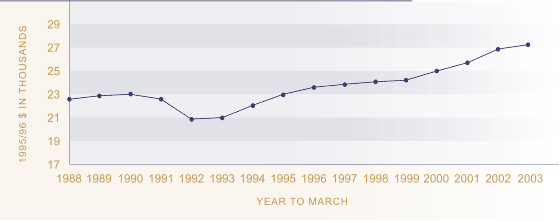Relevance
Per capita national disposable income gives a measure of the average income available to New Zealanders. A nation with rising per capita RGNDI will have a greater capacity to deliver a better quality of life and standard of living to the population.
Current Level And Trends
In the year to March 2003, RGNDI per person was $27,237 in constant 1995/1996 dollars compared with $22,573 in 1988 (1995/1996 dollars). This represents an average growth rate over the period of 1.26 percent per year. RGNDI grew slowly between 1988 and 1990, before falling to below its 1988 level by 1992. Since 1992, there has been steady growth. This growth reflects the slow but steady increase in the ratio of capital to labour, productivity gains, as well as increasing labour force participation and declining unemployment.
Figure EC1.1 Real gross national
disposable income per capita, 1988-2003

Source: Statistics New Zealand
International Comparison
Comparisons with other OECD countries are available for a similar measure, real gross domestic product (GDP) per person. Using real GDP per person in current US dollars, adjusted for purchasing power parity, New Zealand ranked 21st out of 30 OECD countries in 2002.49 By way of comparison, New Zealand was the 19th most prosperous country out of 26 countries in 1986, and the 10th most prosperous in 1970. Between 1986 and 2002, real GDP per person in New Zealand grew by 20 percent compared with an OECD average of 35 percent.
Economic Value Of Unpaid Work
RGNDI does not take into account the value of unpaid work such as looking after children, cooking meals at home, fixing the car, or voluntary work in the community. The estimated value of unpaid work in New Zealand in 1999 was $39,637 million (1998/1999 dollars), equivalent to 39 percent of gross domestic product (GDP).50 This equates to an annual salary of $13,820 for the average unpaid household worker. Alternatively, the economic value of unpaid work is equivalent to $9,944 per capita (1995/1996 dollars).
